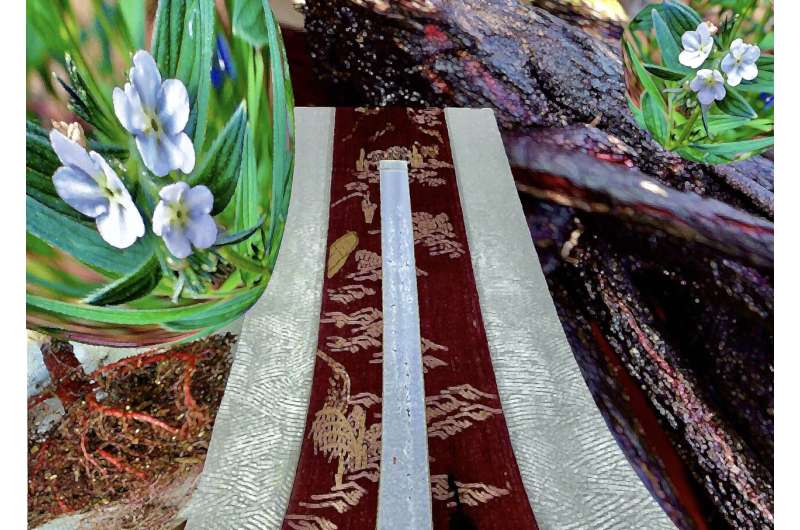Hanging by a purple thread: Study highlights threats to murasaki plant

Purple is a color that has historically been associated with nobility around the world. Japan is no exception. However, its distinct murasaki hue is threatened as the native gromwell plant—synonymous with murasaki—has become an endangered species.
Disease and cross-breeding with non-native species are partly to blame for murasaki’s growing demise.
Now, a research group including Kyoto University is leading a movement to raise awareness of gromwell’s importance in preserving Japanese culture. For example, murasaki revival projects currently underway throughout Japan are investigating the seed’s origins and educating the public on the importance of protecting the plant’s homogeneity.
The team’s paper appeared on May 18, 2023 in Plant and Cell Physiology.
“Various non-profits involved in the revival of gromwell are also keen to maintain the silk staining technique through the collaboration with plant scientists,” says lead author Kazufumi Yazaki.
Purple gromwell—or Lithospermum erythrorhizon—contains shikonin derivatives in the plant’s root surfaces, which are red naphthoquinones. This natural pigment and medicinal properties are linked to ancient East Asian traditions. Among the range of hues, the most sought dye was the dark purple reserved for members in the top levels of government and the Imperial family, as well as the highest-ranking Buddhist monks.
“The purple color was also used for a national treasure called Koku-Bun-Ji Kyo, the ten-volume Buddhist scripture papers on which letters were written with gold,” says co-author Ryosuke Munakata of KyotoU’s Research Institute for Sustainable Humanosphere.
For medicinal purposes, the roots are prescribed in several remedies as an ointment called Shi-Un-Koh, which is still popular today in treating hemorrhoids, burns, frostbite, and other wounds.
Recovery initiatives, such as the Mitaka Gromwell Restoration Project, are focused on ensuring the native gromwell’s survival, impacted by the spread of cucumber mosaic virus and sudden environmental changes. Cross-breeding with the European species L officinale is another factor in this plant’s uncertain future.
Excavated official wooden documents from Kyushu—found to have been used to transport cargo during the Asuka dynasty—were unexpectedly related to gromwell, highlighting its purple dye’s crucial administrative role.
“We hope our research raises awareness of murasaki’s importance in Japanese history and culture,” comments co-author Emi Ito of Ochanomizu University.
More information:
Emi Ito et al, Letter to the Editor: Gromwell, a Purple Link between Traditional Japanese Culture and Plant Science, Plant And Cell Physiology (2023). DOI: 10.1093/pcp/pcad038
Citation:
Hanging by a purple thread: Study highlights threats to murasaki plant (2023, May 18)
retrieved 18 May 2023
from https://phys.org/news/2023-05-purple-thread-highlights-threats-murasaki.html
This document is subject to copyright. Apart from any fair dealing for the purpose of private study or research, no
part may be reproduced without the written permission. The content is provided for information purposes only.
For all the latest Science News Click Here
For the latest news and updates, follow us on Google News.

